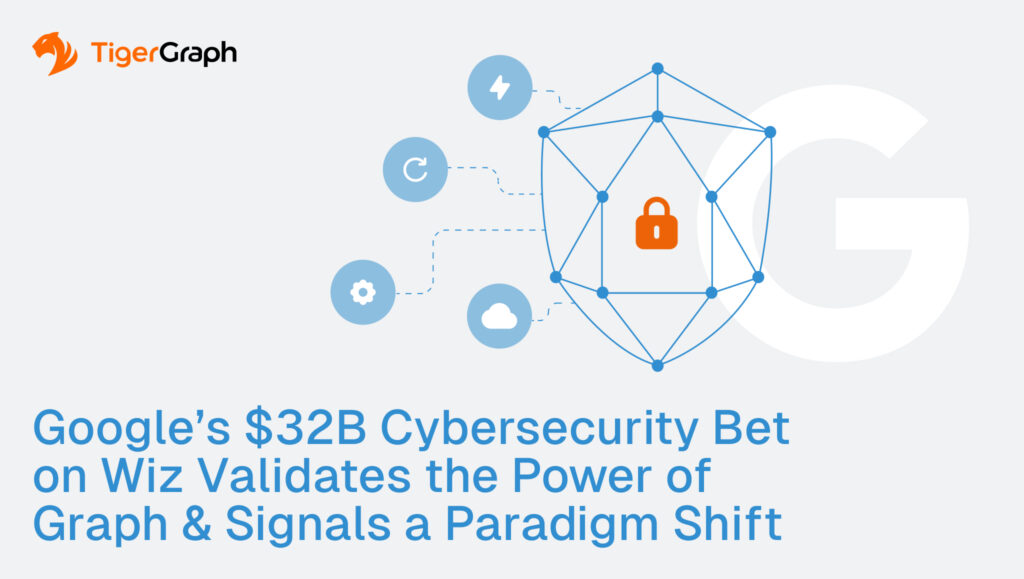Google’s $32B Cybersecurity Bet on Wiz Validates the Power of Graph & Signals a Paradigm Shift
Google’s recent agreement to acquire cloud security firm Wiz for $32 billion marks a significant inflection point in the cybersecurity landscape. It isn’t just a high-stakes business deal—it’s a signal flare, and the message is clear: modern threats require modern defenses, and that means rethinking how we detect, contextualize, and respond to cyber risk.
And at the heart of this evolution lies a technology that’s been gaining quiet momentum: graph.
From Static Defense to Contextual Awareness
The acquisition represents a turning point from reactive, siloed security approaches toward proactive, contextual threat detection.
Wiz creates a unified graph of cloud infrastructure—an interconnected map of resources, vulnerabilities, permissions, and behaviors across multi-cloud environments like AWS, Azure, and Google Cloud. This graph-centric approach enables security teams to quickly understand not just what is happening, but why it’s happening and how it might spread.
“Wiz’s solution rapidly scans the customer’s environment, constructing a comprehensive graph of code, cloud resources, services, and applications – along with the connections between them. It identifies potential attack paths, prioritizes the most critical risks based on their impact, and empowers enterprise developers to secure applications before deployment. It also helps security teams collaborate with developers to remediate risks in code or detect and block ongoing attacks.”
While Wiz uses graph at the application layer—mapping cloud resources, connections, and vulnerabilities to visualize and act on risk—the deeper story is about how that graph is constructed, scaled, and queried in real time.
Wiz shows what’s possible when you model security context as a graph—but the infrastructure challenge is:
- Can you handle billions of nodes and relationships?
- Can you run multi-hop, context-aware queries as threats are unfolding?
- Can you power both real-time decisions and deep analytics on top of this complex graph?
That’s where TigerGraph comes in.
Wiz’s approach validates the importance of graph—but TigerGraph enables it at enterprise scale. It’s the difference between using graph to display insights and using graph to power the entire detection and response system. One is a snapshot; the other is a real-time engine.
But let’s take a step back to see why graph, itself, is such an improvement and how TigerGraph elevates the experience even further.
Graph Isn’t Just Faster, It’s Fundamentally Different
Traditional databases—like relational systems—are built to handle structured data in tables. But cybersecurity challenges don’t follow neat tabular rules. Modern threats are dynamic, multi-layered, and deeply interconnected. Graph databases are purpose-built to model these complex relationships—between users, systems, credentials, devices, actions, and more.
That’s why graph isn’t just a faster way to query data—it’s a more appropriate and powerful model for the problem at hand. And when operating at scale with real-time demands, TigerGraph’s unique architecture delivers where others fall short.
Unlike general-purpose graph databases, TigerGraph is engineered from the ground up to process complex, multi-hop queries using distributed and parallel computing. That translates to:
- Rapid threat detection, even when malicious activity moves laterally across users and systems.
- Real-time behavioral analysis that identifies anomalies as they occur—not after.
- Enterprise-grade speed and throughput that scales with your cloud environment.
TigerGraph is more than a database—it’s the real-time engine behind intelligent cybersecurity platforms.
Distributed Graph Engine Purpose-built for Cybersecurity
Not all graph technology is created equal. While Wiz uses graph structures to power its application-layer insights, TigerGraph could take it deeper, offering a distributed, high-performance graph engine purpose-built for the demands of modern cybersecurity operations.
Our key differentiators include:
- Native support for massive scale and parallel execution across distributed infrastructure.
- Optimized pattern matching and deep link traversal across billions of nodes and edges.
- Real-time analytics performance for mission-critical, in-the-moment security decisions.
This isn’t graph as a visual tool—it’s graph as infrastructure.
When many people hear “graph,” they think of a visualization—dots and lines showing how people are connected on a social network or how devices are linked in a network diagram. That kind of visual graph can be useful for understanding relationships at a high level, but it’s not what powers real-time cybersecurity.
In this context, the graph is the underlying architecture—a way of structuring and querying data that emphasizes the connections between things, not just the things themselves. It’s about transforming relationship data into a real-time reasoning layer for detection, prevention, and response.
Cyber threats aren’t isolated events. They unfold as sequences of actions across systems—user logins, access requests, file downloads, API calls, and permission changes. Traditional systems often log these as disconnected events, making it hard to see the bigger picture.
Graph infrastructure flips that model. It allows you to:
- Represent relationships explicitly—so you can model “who has access to what,” “what talks to what,” and “how those elements change over time.”
- Query across those relationships in real time—asking deep, context-rich questions like:
“Has this user accessed resources they normally don’t?”
“Is this IP connected to a previously known threat actor?”
“Does this behavior form a suspicious pattern across systems?” - Reason across connections dynamically—so the system can spot patterns of lateral movement or privilege escalation as they’re unfolding, not hours later.
That’s what turns a graph into a reasoning engine, not just a static map. And when it’s backed by a platform like TigerGraph—designed for high-speed, distributed traversal—you get real-time, scalable threat intelligence.
Where Cybersecurity Is Headed—and Why Graph Leads the Way
We’re helping cybersecurity leaders move beyond siloed alerts and reactive defenses toward something more proactive, intelligent, and context-aware. Take one real-world example: Security platforms using TigerGraph to classify and assess newly registered websites before they can be weaponized for phishing or malware.
How? By connecting data points like domain registrars, SSL certificates, IP histories, user agents, and DNS records—then running real-time graph analytics across those connections. This reveals subtle, emerging threat patterns that would be invisible to traditional, row-by-row analysis. Layer in machine learning, and these systems can detect risky behaviors that resemble what known threat actors have done before—even when the attack is brand new.
The result? Actionable insights before the attack ever begins.
Cybersecurity today isn’t about static rules or hardened perimeters. It’s about operating in dynamic, constantly shifting environments—where identities are fluid, access is everywhere, and attacks evolve in seconds.
That’s why cybersecurity is fundamentally a contextual or relationship-driven problem.
This problem is one where the danger lies not in any single event, but in how events relate to one another. In cybersecurity, this could be a sequence of login attempts, a chain of credential access, or a subtle shift in a user’s behavior over time. Traditional databases aren’t designed to detect these complex chains. They see records. Graphs see relationships.
Graph databases provide the connective tissue needed to model and monitor this complexity.
And not all graph solutions are created equal. TigerGraph is purpose-built to solve these challenges at scale:
- Mapping deep relationships across millions of users, assets, and events in real-time.
- Surfacing anomalies based on how threats typically move and spread—not just what they look like.
- Powering explainable AI that helps security teams not only detect threats but understand why they’re threats.
TigerGraph offers context-rich solutions to cybersecurity’s context-deficit problem.
Google’s $32B acquisition of Wiz may grab headlines, but the deeper takeaway is clear: the industry is shifting toward architectures that rely on real-time graph reasoning. Because tomorrow’s security challenges won’t be solved with yesterday’s tools.
TigerGraph enables that shift—turning complex, distributed threat data into precise, actionable intelligence at enterprise scale.
Want to see how graph analytics can supercharge your threat detection and response? Let’s talk.

